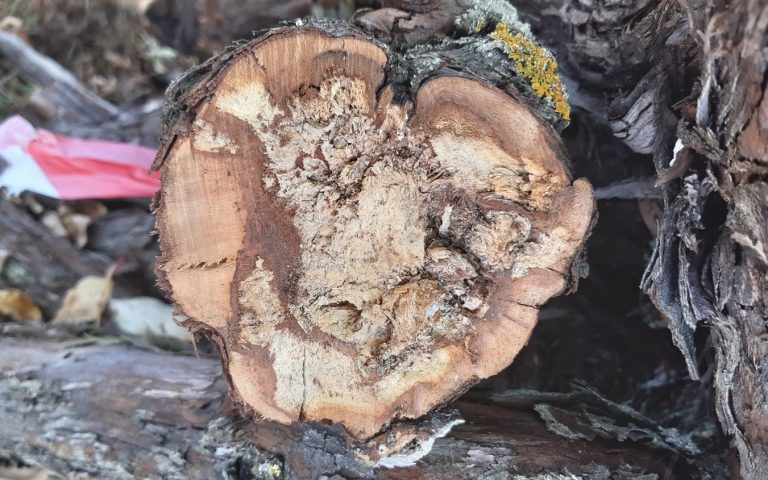
There are historical sources describing at least one trunk disease in grapevine in ancient Roman and Greek civilizations as well as in the Mediterranean Middle Ages, with some authors suggesting that it may be as old as viticulture itself (Mugnai et al. 1999).
Nowadays, Grapevine trunk diseases (GTDs) are present in every grapevine-growing country. This designation refers to a group of wood diseases that affect the woody structures of grapevine plants, causing different symptoms in wood, leaves, twigs and berries, and eventually sudden or progressive decline of the affected plants, therefore reducing drastically the life of a vineyard (Bertsch et al. 2013; Kenfaoui et al. 2022). Their impacts are significant on many levels; they damage the viticultural landscape, cause reduction in grape yield, wine production and quality, and have a significant impact on the wine market and winegrowing economies generally. Particularly over the last two decades, GTDs’ incidence rose to alarming levels in most grapevine growing regions (especially in the Mediterranean basin), rendering a large percentage of affected vineyards unproductive (Guérin-Dubrana et al., 2019). In countries where the wine market is extremely important like France, loss in production is estimated at around a billion U.S. dollars per year, and numbers from California and Australia are on the order of millions and billions of dollars per year, respectively (Siebert 2001)(Fontaine et al. 2016). Learning to combat them more effectively is essential.
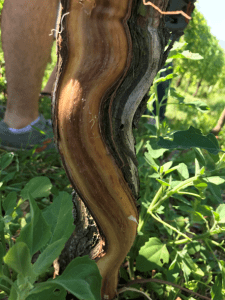

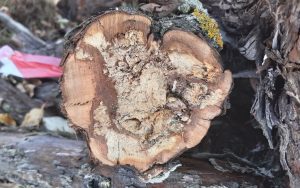
Solutions for Combatting GTDs
Various curative and preventative solutions have been proposed over the course of time. Early strategies likely consisted of simply removing the affected plants. The twentieth century saw the widespread use of chemical pesticides like sodium arsenite against the Esca complex of diseases. While effective, over the last 30 years, most chemicals have been banned for environmental and toxicity concerns. Physical interventions, such as trunk renewal, trunk surgery (curettage) and good pruning techniques, are the most efficient, while the use of biocontrol agents has also proven effective to an extent (Mondello et al. 2018; Pacetti et al. 2021; SICAVAC 2022). However, for several reasons, some of these techniques are not always viable either financially or practically. There is a clear need for alternative sustainable and environmentally friendly strategies.
In the quest for alternative solutions, fundamental research on the pathogens and their mechanisms of action and interaction with grapevine plants is crucial. Indeed, these diseases are mostly associated with fungal pathogens, entering the plants mainly through pruning wounds, causing lesions and necrosis formation in wood as well as unique leaf symptom patterns.
The Esca Complex of Diseases
The Esca complex remains one of the most catastrophic GTDs, nowadays regrouping four different syndromes: Petri disease, brown wood streaking, grapevine leaf stripe disease (GLSD) and white rot (Surico 2009). The fungi behind each disease belong to two different groups: Ascomycetes and Basidiomycetes fungi (the two ascomycetes historically associated with the complex of diseases are Phaeomoniella chlamydospora (Pch) (Crows and Grams 2000) and Phaeoacremonium minimum (Pmin) (Gramaje et al. 2015.)) They cause multiple types of necrosis in the trunk of the vines while also often leading to “tiger stripe leaves”, the foliar manifestation of GLSD (Figures 1 and 2).
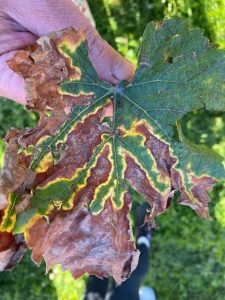
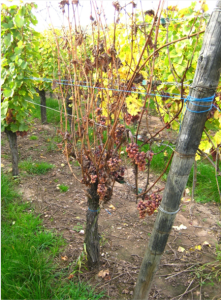
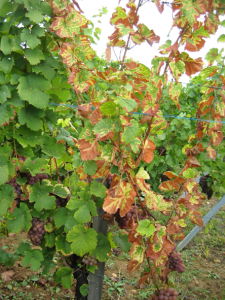
The main fungus responsible for the white rot syndrome is usually a Basidiomycete fungus, most often a Fomitiporia species, that usually varies according to geographical region (Fischer 2006). In Europe, Fomitiporia mediterranea (Fmed) (Fischer 2002) is the main fungus responsible for white rot. The syndrome causes the complete degradation of the wood attacked, reducing it to a spongy-yellowish residue, therefore irreversibly compromising the physical structure of the plants and the water transport. In old vineyards, the situation in which both white rot and GLSD are present is more often observed, raising a series of question marks on possible links between Fomitiporia species and the tiger stripe leaf patterns, historically associated with Ascomycetes fungi species (these two diseases manifesting together are sometimes referred to as ‘Esca proper’ (Surico 2009.) Considering all these interactions, it is easy to understand the devastating impact caused by this complex of diseases.
Mechanisms of Action
Understanding the mechanisms behind the pathogens’ activity in the Esca complex is crucial for predicting their behavior, and preventing or counteracting the damage they can cause. Past research efforts in this context have mostly focused on two main fronts: firstly, attempts to identify compounds (either released by the fungi or by the degrading wood) possibly responsible for the typical foliar symptoms, potentially being transported to the vines’ leaves via the sap (never fully demonstrated); and secondly, the study of wood necrosis and lesions formation and wood degradation, the latter mainly attributed to enzymes secreted by the fungi to decompose lignin and cellulose, the main wood constituents (Sparapano et al. 2001; Claverie et al. 2020; Pacetti et al. 2022).
Moreover, most likely because of the historical conviction that Basidiomycetes species can only arrive once the terrain has been prepared by other fungi, research has mostly focused on Ascomycetes fungi, leaving the role of Basidiomycetes species quite unexplored in the Esca complex. However, a recent observation coming from trunk surgery confirmed what some researchers had suspected: the complete removal of white rot drastically reduced the foliar symptoms (Pacetti et al. 2021; Lecomte et al. 2022). This suggests that Basidiomycetes (such as Fmed) are not mere secondary pathogens degrading wood but might actually have a larger role in the Esca complex of diseases, fueling interest in studying their role in the disease, recently highlighted by other researchers (Brown et al. 2020).
Recent Research on Fomitiporia mediterranea
In our laboratory, we made Fmed a main research topic, taking innovative approaches to study the pathogenesis mechanisms of the fungus in collaboration with two other research groups, one led by Laura Mugnai (University of Florence, Italy) and the other led by Barry Goodell (University of Massachusetts, USA), world-renowned experts in Esca complex and wood decay mechanisms, respectively. Fungal wood degradation has always been theorized in the framework of a binary division between white rot in which the main process involves enzymes, and brown rot in which the main process involves chemical compounds and their interaction with iron present in the wood cells, generating free radicals (a non-enzymatic process) (Blanchette 1991; Goodell 2020).
Our approach was motivated in large part by recent genomic studies calling into question the white rot versus brown rot paradigm (Riley et al. 2014). We analyzed the possibility for Fmed, a white rot fungus, to adopt a series of chemical reactions of a non-enzymatic nature that ultimately produces free radicals (namely hydroxyl radicals) to start wood degradation. It is in fact well demonstrated that in intact wood cell walls, micropores are too small to allow enzymes to pass through and digest wood (Flournoy et al. 1991; Kleman-Leyer et al. 1992). These mechanisms have been recently proven possible for the other two Ascomycetes fungi involved in the Esca complex as well as for Eutypa lata, mainly involved in Eutypa dieback, another GTD (Perez-Gonzalez et al. 2022). Our in vitro research demonstrates that the non-enzymatic mechanisms producing free radicals are possible for Fmed too (Moretti et al. 2023), further confirming that decay mechanisms can be much more nuanced than a reductive binary classification while also offering new possibilities for disease control.
Future Perspectives
Indeed, what may seem a mere technical distinction does in fact have significant implications for real-world applications. Understanding that every main fungus involved in the Esca complex can employ some non-enzymatic mechanisms to produce free radicals immediately points to a possible new research approach to controlling and fighting the disease: antioxidants and chelators, which are substances that bind free radicals and iron, respectively. Targeted use of antioxidants and/or iron chelator could therefore in theory reduce this non-enzymatic degradation process, by rendering free radicals inactive or iron unavailable for the non-enzymatic processes. In vitro results on other GTD fungi are encouraging as it appears that free radical production is reduced or completely blocked in the presence of antioxidants/chelators (Sebestyen et al. 2022). Their impact on free radical production by Fmed needs to be tested with research conducted in plants and in the field that tests various application methods for any resulting reduction in wood necrosis and degradation. If antioxidants/chelators prove to be an effective potential way to control symptoms of the Esca complex, research should identify sustainable and environmentally friendly sources. This research approach could also be extended to other GTDs and respective pathogens.
References
Bertsch, C., Ramírez-Suero, M., Magnin-Robert, M., Larignon, P., Chong, J., Abou-Mansour, E., Spagnolo, A., Clément, C., Fontaine, F. (2013). Grapevine trunk diseases: Complex and still poorly understood. Plant Pathol. 62, 243–265. doi:10.1111/j.1365-3059.2012.02674.x.
Blanchette, R. A. (1991). Delignification by wood-decay fungi. Annu. Rev. Phytopathol. 29, 381–398. doi:10.1146/annurev.py.29.090191.002121.
Brown, A. A. A., Lawrence, D. P. P., Baumgartner, K. (2020). Role of basidiomycete fungi in the grapevine trunk disease esca. Plant Pathol. 69, 205–220. doi: 10.1111/ppa.13116.
Claverie, M., Notaro, M., Fontaine, F., Wéry, J. (2020). Current knowledge on Grapevine Trunk Diseases with complex etiology: a systemic approach. Phytopathol. Mediterr. 59, 29–53. doi:10.14601/Phyto-11150.
Crous, P. W., Gams, W. (2000). Phaeomoniella chlamydospora gen. et comb. nov., a causal organism of Petri grapevine decline and esca. Phytopathol. Mediterr. 39, 112–118. doi:10.14601/Phytopathol_Mediterr-1530.
Fischer, M. (2002). A new wood-decaying basidiomycete species associated with esca of grapevine: Fomitiporia mediterranea (Hymenochaetales). Mycol. Prog. 1, 315–324. doi:10.1007/s11557-006-0029-4.
Fischer, M. (2006). Biodiversity and geographic distribution of basidiomycetes causing esca-associated white rot in grapevine: A worldwide perspective. Phytopathol. Mediterr. 45, 30–42. doi:10.14601/Phytopathol_Mediterr-1846.
Flournoy, D.S., Kirk, T.K., Highley, T.L. (1991). Wood decay by brown-rot fungi: changes in pore structure and cell wall volume. Holzforschung 45, 383–388. doi:10.1515/hfsg.1991.45.5.383.
Fontaine, F., Gramaje, D., Armengol, J., Smart, R., Nagy, Z.A., Borgo, M., Rego, C.,Corio-Costet, M.F. Grapevine Trunk Diseases. A Review. OIV Publications: Paris, France, 2016; p. 25.
Goodell, B. (2020). Fungi Involved in the Biodeterioration and Bioconversion of Lignocellulose Substrates. In The Mycota.(A Comprehensive Treatise on Fungi as Experimental Systems for Basic and Applied Research) vol 2. Genetics and Biotechnology; Benz, J.P., Schip-827 per, K., Eds.; Springer Cham: Switzerland; Vol. 2, pp. 369–397, doi: 10.1007/978-3-030-49924-2_15.
Gramaje, D., Mostert, L., Groenewald, J. Z., Crous, P. W. (2015). Phaeoacremonium: From esca disease to phaeohyphomycosis. Fungal Biol. 119, 759–783. doi:10.1016/j.funbio.2015.06.004.
Guérin-Dubrana, L., Fontaine, F., Mugnai, L. (2019). Grapevine trunk disease in European and Mediterranean vineyards: occurrence, distribution and associated disease-affecting cultural factors. Phytopathol. Mediterr. 58, 49–71. doi:10.14601/Phytopathol_Mediterr-25153.
Kenfaoui, J., Radouane, N., Mennani, M., Tahiri, A., El Ghadraoui, L., Belabess, Z., Fontaine,
F., El Hamss, H., Amiri, S., Lahlali, R., Barka EA.(2022). A Panoramic View on Grapevine Trunk Diseases Threats: Case of Eutypa Dieback, Botryosphaeria Dieback, and Esca Disease. J. Fungi, 8, 595. doi: 10.3390/jof8060595.
Kleman-Leyer K., Agosin E., Conner A.H., Kirk T.K. (1992) Changes in molecular size distribution of cellulose during attack by white rot and brown rot fungi. Appl. Environ. Microbiol. 58,1266–1270. doi: 10.1128/aem.58.4.1266-1270.1992.
Lecomte, C., Cholet, C., Bruez, E., Martignon, T., Giudici, M., Simonit, M., Alonso Ugaglia, A., Forget, D., Miramon, J., Arroyo, M., Dubourdieu, D., Geny-Denis, L., Rey, P. (2022). Recovery after curettage of grapevines with esca leaf symptoms. Phytopathol. Mediterr. 61, 473-488. doi: 10.36253/phyto-13357.
Mondello, V., Songy, A., Battiston, E., Pinto, C., Coppin, C., Trotel-Aziz, P., Clément, C., Mugnai, L., Fontaine, F. (2018). Grapevine trunk diseases: A review of fifteen years of trials for their control with chemicals and biocontrol agents. Plant Dis. 102, 1189–1217. doi:10.1094/PDIS-08-17-1181-FE.
Moretti, S., Goddard, M.-L., Puca, A., Lalevée, J., Di Marco, S., Mugnai, L., Gelhaye, E., Goodell, B., Bertsch, C., Farine, S. (2023). First Description of Non-Enzymatic Radical-Generating Mechanisms Adopted by Fomitiporia mediterranea: An Unexplored Pathway of the White Rot Agent of the Esca Complex of Diseases. J. Fungi 9, 498. https://doi.org/10.3390/jof9040498
Mugnai, L., Graniti, A., Surico, G. (1999). Esca (black measles) and brown wood-streaking: two old and elusive diseases of grapevines. Plant Dis. 83, 404–418. doi: 10.1094/PDIS.1999.83.5.404.
Pacetti, A., Moretti, S., Pinto, C., Compant, S., Farine, S., Bertsch, C., Mugnai, L. (2021). Trunk Surgery as a Tool to Reduce Foliar Symptoms in Diseases of the Esca Complex and Its Influence on Vine Wood Microbiota. J. Fungi 7, 1–26. doi:https://doi.org/10.3390/ jof7070521.
Pacetti, A., Moretti, S., Perrin, C., Gelhaye, E., Bieler, E., Kassemeyer, H.-H., Mugnai, L., Farine, S., Bertsch, C. (2022). Grapevine Wood Degrading Activity of Fomitiporia mediterranea M. Fisch.: A Focus on the Enzymatic Pathway Regulation. Front. Microbiol. 804, 13, 844264, doi:10.3389/fmicb.2022.844264.
Perez-Gonzalez, G., Sebestyen, D., Petit, E., Jellison, J., Mugnai, L., Gelhaye, E., Lee, N., Farine, S., Bertsch, C., Goodell, B. (2022) Oxygen Radical-Generating Metabolites Secreted by Eutypa and Esca Fungal Consortia: Understanding the Mechanisms Behind Grapevine Wood Deterioration and Pathogenesis. Front. Plant Sci. 13:921961. doi: 10.3389/fpls.2022.921961
Riley, R., Salamov, A. A., Brown, D. W., Nagy, L. G., Floudas, D., Held, B. W., Levasseur, A., Lombardf V., Morin, E., Otillar, R., Lindquist, E. A., Sun, H., LaButti, K. M., Schmutz, J., Jabbour, D., Luo, H., Baker, S. E., Pisabarro, A. G., Walton, J. D., Blanchette, R. A., Henrissat, B., Martin, F., Cullen, D., Hibbett, D. S., Grigoriev, I. V. (2014). Extensive sampling of basidiomycete genomes demonstrates inadequacy of the white-rot/brown-rot paradigm for wood decay fungi. Proc. Natl. Acad. Sci. 111, 9923–9928. doi:10.1073/pnas.1400592111.
Sebestyen, D., Perez-Gonzalez, G., Goodell, B. (2022). Antioxidants and iron chelators inhibit oxygen radical generation in fungal cultures of plant pathogenic fungi. Fungal Biol. 126: 480-487. doi: 10.1016/j.funbio.2022.04.002.
SICAVAC, (2022). Bonnes Pratiques de Taille et Techniques Curatives Contre les Maladies du Bois, SICAVAC & B.IV.C., Imprimerie Paquereau, Angers, France, 138 pp. ISBN 978-2-9584692-0-7.
Sparapano, L., Bruno, G., Graniti, A. (2001). Three year observation of grapevines cross-inoculated with esca associated fungi. Phytopathol. Mediterr. 40, S376–S386. doi: 10.14601/Phytopathol_Mediterr-1643.
Surico, G. (2009). Towards a redefinition of the diseases within the esca complex of grapevine. Phytopathol. Mediterr. 48, 5–10. doi:10.14601/Phytopathol_Mediterr-2870.
Siebert, J.B. (2001). Eutypa: The economic toll on vineyards. Wines & Vines (April), 50-56.











